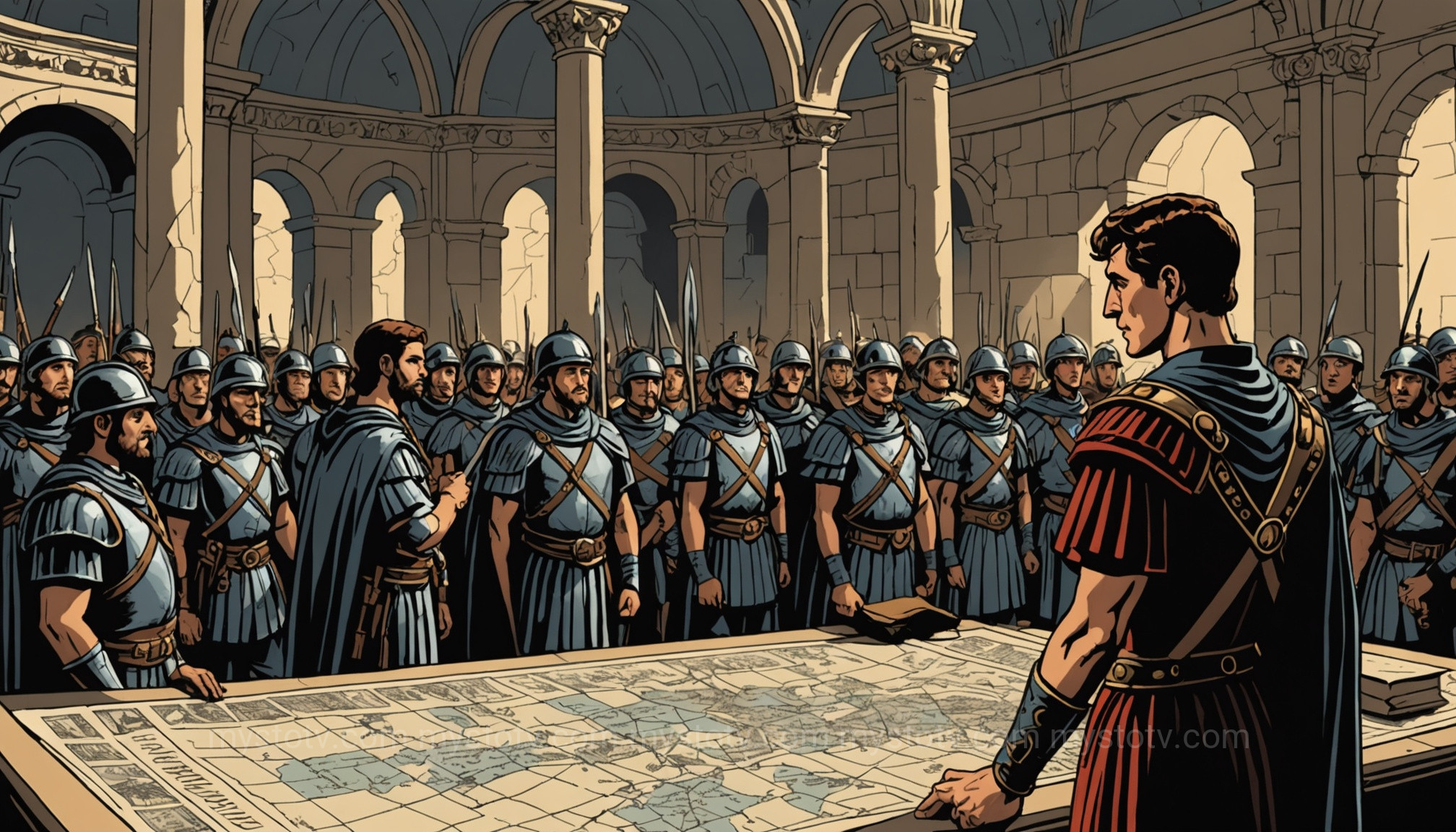I still remember the illustration in my childhood history book: a regal queen, draped in finery, defiantly pressing a small snake to her breast. The caption was simple and absolute, stating it as fact. For years, I, like millions of others, accepted this dramatic, cinematic ending. It wasn't until a late-night documentary binge, watching historians and toxicologists dissect the scene, that a crack appeared in that perfect story. They presented evidence so compelling it made me question everything I thought I knew. The simple question of how did Cleopatra die suddenly wasn't so simple anymore. It was a complex puzzle of propaganda, science, and political intrigue. This realization sparked a personal fascination with separating the woman from the myth, starting with the very end of her life.
Contents
- 1 The Roman Narrative: How Did Cleopatra Die According to Plutarch's Legend?
- 2 Deconstructing the Legend: Why Experts Question How Did Cleopatra Die by an Asp
- 3 The Poison Hypothesis: A More Calculated Answer to How Did Cleopatra Die?
- 4 The Shadow of Octavian: Was the Truth of How Did Cleopatra Die a Political Assassination?
- 5 The Enduring Myth: Why the Question of How Did Cleopatra Die Still Captivates Us
- 6 FAQ on the Death of Cleopatra
- 7 Conclusion: The Unsolved Case of a Queen's Final Act
- 8 References
The Roman Narrative: How Did Cleopatra Die According to Plutarch's Legend?

The most famous story of Cleopatra's demise is a masterpiece of historical drama, penned not by an eyewitness, but by the Greek-Roman historian Plutarch nearly two centuries after the event. Writing his "Life of Antony" around 100-120 AD, Plutarch crafted a narrative that has shaped our collective imagination for millennia. According to his account, following her defeat at the Battle of Actium and the subsequent suicide of her lover, Mark Antony, Cleopatra was taken prisoner by the victorious Octavian (the future Emperor Augustus).
Determined to avoid the ultimate humiliation of being paraded through the streets of Rome in a triumphal procession, Cleopatra resolved to take her own life. Plutarch writes that the means of her death was an asp—commonly identified as an Egyptian cobra—smuggled to her in a basket of figs. Upon discovering the serpent, she supposedly declared, "So here it is," and held it to her arm until it bit her. Her two devoted handmaidens, Iras and Charmion, followed their queen in death. When Octavian's guards burst into her mausoleum, they found the queen dead upon her golden couch, Iras dead at her feet, and Charmion, staggering, adjusting the diadem on Cleopatra's head before collapsing herself. This account of how did Cleopatra die is undeniably powerful, portraying her as a proud, defiant monarch who controlled her own destiny to the very end.
Other Roman-era historians, like Cassius Dio, tell a similar story, though with slight variations. Dio suggests the snake might have been brought in a water pitcher or that she used a hollow pin (a "knestis") smeared with snake venom to prick herself. Despite these minor differences, the core elements remained consistent: a secret plan, a hidden snake, and a swift, self-inflicted death. This version served Roman propaganda perfectly. It painted Cleopatra not as a victim of Roman conquest, but as a treacherous, mystical Eastern queen whose end was as exotic and dramatic as her life. It was a tidy, politically convenient conclusion to a messy chapter in Roman history.
Deconstructing the Legend: Why Experts Question How Did Cleopatra Die by an Asp
For all its dramatic flair, the traditional story of how Cleopatra died begins to crumble under modern scrutiny. Historians, toxicologists, and Egyptologists have raised significant doubts about the logistics and medical realities of Plutarch's account. The asp narrative, while a potent symbol, is fraught with practical inconsistencies that suggest it may be more fiction than fact.
The Logistical Nightmare: Smuggling a Deadly Cobra

The first major hurdle is the snake itself. The "asp" is widely believed to be an Egyptian cobra (Naja haje), a species native to the region. These are not small, discreet creatures. A mature Egyptian cobra can reach lengths of 1.5 to 2.4 meters (5 to 8 feet). Hiding a snake of this size—one that is likely to be agitated and defensive—in a small basket of figs and getting it past vigilant Roman guards seems highly improbable. Cleopatra was Octavian's most prized captive; her tomb would have been under heavy surveillance. The idea that such a conspicuous and dangerous weapon could be so easily smuggled in challenges credulity. It’s a detail that works beautifully in a story but falters when examined as a real-world security breach.
The Medical Inconsistencies: The Reality of Snakebite Venom
The second, and perhaps more compelling, argument against the asp theory lies in the nature of snakebite itself. The romanticized version of how did Cleopatra die suggests a quick, serene, and painless end. The reality of a cobra bite is anything but.
Cobra venom is a potent neurotoxin, but its effects are not instantaneous. Death from a cobra bite is often slow and agonizing. Symptoms include intense localized pain, swelling, blistering, and necrosis (tissue death) at the bite site. Systemic effects follow, including blurred vision, vertigo, paralysis of the respiratory muscles, and eventual suffocation. This process can take several hours and is far from the "quiet and easy" death that ancient sources sometimes imply Cleopatra sought. Furthermore, snakebites are not always fatal. Snakes can deliver a "dry bite" with no venom, or an insufficient amount to kill a human. For a queen leaving nothing to chance, relying on the unpredictable behavior of a wild animal would have been an incredibly risky gamble. Her death needed to be certain, and a snakebite was anything but.
The Problem of Multiple Deaths: A Single Snake, Three Victims?
Perhaps the most damning piece of evidence against the single-snake theory is the death of Cleopatra's handmaidens, Iras and Charmion. The legend has all three dying in quick succession within the same sealed room. Is it plausible that a single cobra, after delivering a fatal bite to the queen, would then proceed to bite and kill both of her attendants in a matter of minutes?
Experts in herpetology find this scenario extremely unlikely. After delivering a significant bite, a snake would need time to replenish its venom. Furthermore, its instinct would be to retreat and hide, not to seek out additional targets. For one snake to be responsible for three rapid deaths is a statistical improbability. This inconsistency forces us to reconsider the entire premise. If a snake wasn't the cause, then the question of how did Cleopatra die is thrown wide open, pointing toward a method that could reliably and simultaneously dispatch three people.
The Poison Hypothesis: A More Calculated Answer to How Did Cleopatra Die?

If not a snake, then what? A growing number of scholars, led by figures like German historian Christoph Schäfer, propose a much more plausible and scientifically sound theory: Cleopatra died by ingesting a powerful poison cocktail. This hypothesis aligns far better with the historical context, Cleopatra's known character, and the logistical requirements for a certain, swift, and relatively dignified death.
A Queen's Knowledge: Cleopatra's Expertise in Toxicology
Cleopatra was no ordinary monarch. She was highly educated, fluent in multiple languages, and renowned for her intellect. Importantly, ancient sources note her keen interest in pharmacology and toxicology. It's well-documented that she experimented with various poisons, testing their effects on prisoners to observe their lethality and the manner of death they caused. She was reportedly searching for a poison that would bring about a rapid and painless end. This portrait of a methodical, scientific queen is a far cry from one who would leave her fate to a wild animal. Her deep knowledge of toxins makes it highly probable that she would have concocted or procured a reliable compound to ensure her death was on her own terms.
The "Quiet and Easy" Death: A Poison Cocktail
The most compelling alternative to the asp is a fast-acting poison, likely a mixture of several substances. The Greek historian Strabo, a contemporary who was in Alexandria shortly after the queen's death, makes no mention of a snake. He simply states that she died by an ointment. Christoph Schäfer and his team have argued that a likely candidate was a mixture of hemlock, wolfsbane, and opium.
This combination would have been lethally effective. Hemlock and wolfsbane are potent neurotoxins that would paralyze the nervous system and stop the heart within a relatively short period. The addition of opium, a powerful sedative, would have rendered the process painless, inducing unconsciousness before death. This method accounts for the "quiet" nature of her passing described by some sources and, crucially, explains how her two handmaidens could have died with her. The three women could have simply drunk the poison together, ensuring their simultaneous demise. This theory resolves the logistical and medical problems of the snake bite story and offers a more credible explanation for how did Cleopatra die.
The Shadow of Octavian: Was the Truth of How Did Cleopatra Die a Political Assassination?

While suicide by poison is the most likely scientific explanation, a darker possibility cannot be dismissed: that Cleopatra was murdered on Octavian's orders. This theory reframes the entire event from a tragic suicide to a cold-blooded political assassination, a final, decisive act by the man who would become Rome's first emperor.
Octavian had every reason to want Cleopatra dead. While he desperately wanted to display her as a captive in his triumph to solidify his power and humiliate the memory of Mark Antony, a living Cleopatra posed an immense threat. She was charismatic, intelligent, and a potent symbol of resistance. More importantly, her son by Julius Caesar, Caesarion (Ptolemy XV), had a legitimate, if tenuous, claim to Caesar's legacy—a direct threat to Octavian's own status as Caesar's adopted son and heir. A public trial or a living, imprisoned queen could incite riots or rally remaining supporters.
As Pat Brown, a criminal profiler who investigated the case, argues, the crime scene as described by Plutarch has all the hallmarks of a staged suicide. The locked room, the conveniently discovered "evidence" of the snake, the tidy narrative—it all serves Octavian's interests perfectly. By allowing (or creating) the story of her suicide, he could eliminate his rival without being seen as a ruthless murderer. He gets the political victory of her death while she retains her tragic dignity, a narrative that prevents her from becoming a martyr. The question of how did Cleopatra die becomes less about her choice and more about Octavian's ruthless ambition. While concrete proof is impossible to find, the motive is undeniable, leaving a permanent shadow of doubt over the official Roman account.
The Enduring Myth: Why the Question of How Did Cleopatra Die Still Captivates Us
For over two thousand years, the story of the asp has triumphed over the more probable, less dramatic theories. The reason for its endurance is a testament to the power of a good story. The image of the queen and the serpent is rich with symbolism: it's a tale of defiance, of exoticism, of sex and death, and of a powerful woman taking control of her fate in the face of insurmountable odds. It's a narrative that has been immortalized by Shakespeare, painted by countless artists, and brought to life on the silver screen. The myth is simply more compelling than the clinical reality of a poison cocktail. Analyzing the legend's inconsistencies reveals much about our love for such narratives.
The ongoing mystery of how did Cleopatra die is also fueled by the absence of her body. Her tomb, which she was said to share with Mark Antony, has never been found. Without a body to examine for forensic evidence—like traces of venom or poison—the truth remains tantalizingly out of reach. This absence of proof allows the myth to flourish, leaving us with a historical cold case that continues to fascinate scholars and the public alike. The debate is not just about historical fact; it's about how we choose to remember one of history's most formidable women—as a romantic heroine of legend or as a pragmatic, calculating ruler to the very end.
FAQ on the Death of Cleopatra
Given the complexities and enduring mysteries, many common questions arise about Cleopatra's final days. Here are answers to a few of the most frequent inquiries.
1. Where is Cleopatra's tomb?
The location of Cleopatra and Mark Antony's tomb is one of the greatest unsolved mysteries in archaeology. Ancient writers, including Plutarch, state that Octavian allowed them to be buried together in a magnificent tomb she had built for herself near a temple of Isis in Alexandria. Despite numerous efforts, it has never been definitively located. Archaeologists like Dr. Kathleen Martinez have famously searched at the site of Taposiris Magna, about 30 miles outside Alexandria, believing it to be a possible location, but as of today, the tomb remains lost, likely submerged beneath the modern city or the sea.
2. What happened to Cleopatra's children after her death?
Cleopatra's children faced different fates. Her eldest son, Caesarion, was hunted down and killed on Octavian's orders shortly after his mother's death, as he was a direct political threat. Her three children with Mark Antony—the twins Alexander Helios and Cleopatra Selene II, and their younger brother Ptolemy Philadelphus—were spared. They were taken to Rome and paraded in Octavian's triumph. Afterwards, they were given to Octavian's sister, Octavia the Younger (who was also Mark Antony's spurned Roman wife), to be raised in her household. Cleopatra Selene II is the only child known to have survived into adulthood; she was eventually married to King Juba II of Numidia and became a powerful and respected ruler of Mauretania.
3. Why did the asp become the accepted symbol of her death?
The asp, or Egyptian cobra, was a powerful symbol in ancient Egypt. It was associated with royalty and divine authority; the Uraeus, a rearing cobra, was worn on the pharaoh's crown as a symbol of protection and power. By choosing a death involving this creature, Cleopatra (or the storytellers after her) was making a profound final statement. She wasn't just committing suicide; she was undergoing a final act of royal transfiguration, dying as a true Egyptian pharaoh, not a Roman captive. This powerful symbolism is a key reason the myth has been so durable compared to the less poetic truth of poison.
Conclusion: The Unsolved Case of a Queen's Final Act
The question of how did Cleopatra die remains one of history's most compelling enigmas. The romantic, tragic tale of the asp, immortalized by Roman propaganda and artistic imagination, presents a defiant queen meeting a symbolic end. Yet, when we move beyond the myth, a far more complex picture emerges. The logical and scientific evidence strongly points away from the unpredictable snake and towards a meticulously planned suicide using a lethal poison—a method befitting a ruler known for her intellect and knowledge of toxicology. And lurking in the shadows of it all is the chilling possibility of a political assassination orchestrated by her conqueror, Octavian.
Ultimately, without the discovery of her tomb, we may never know the definitive truth. But the investigation itself reveals the layers of history, showing how a powerful narrative can obscure a more complicated reality. Cleopatra's death, much like her life, was a major turning point in world history, marking the end of the Ptolemaic dynasty and the dawn of the Roman Empire. The enduring debate ensures that she remains not just a passive figure from a textbook, but an active, brilliant, and mysterious woman whose final choice continues to challenge and captivate us more than two millennia later.
References
- Plutarch. The Life of Antony. (c. 110 AD). http://penelope.uchicago.edu/Thayer/E/Roman/Texts/Plutarch/Lives/Antony*.html
- Dio, Cassius. Roman History. Book 51. (c. 211-233 AD). https://penelope.uchicago.edu/Thayer/E/Roman/Texts/Cassius_Dio/51*.html
- Strabo. Geography. Book 17, Chapter 1. (c. 23 AD). https://penelope.uchicago.edu/Thayer/E/Roman/Texts/Strabo/17A1*.html
- Roller, Duane W. Cleopatra: A Biography. Oxford University Press, 2010.
- Schäfer, Christoph. "Cleopatra's Suicide – a new theory." German Archaeological Institute presentation, 2008. Summarized in various news outlets. For example: The Guardian, "Cleopatra died of drug cocktail not snake bite, claims historian," 2010.
- Bradford, Ernle. Cleopatra. Hodder & Stoughton, 1971.